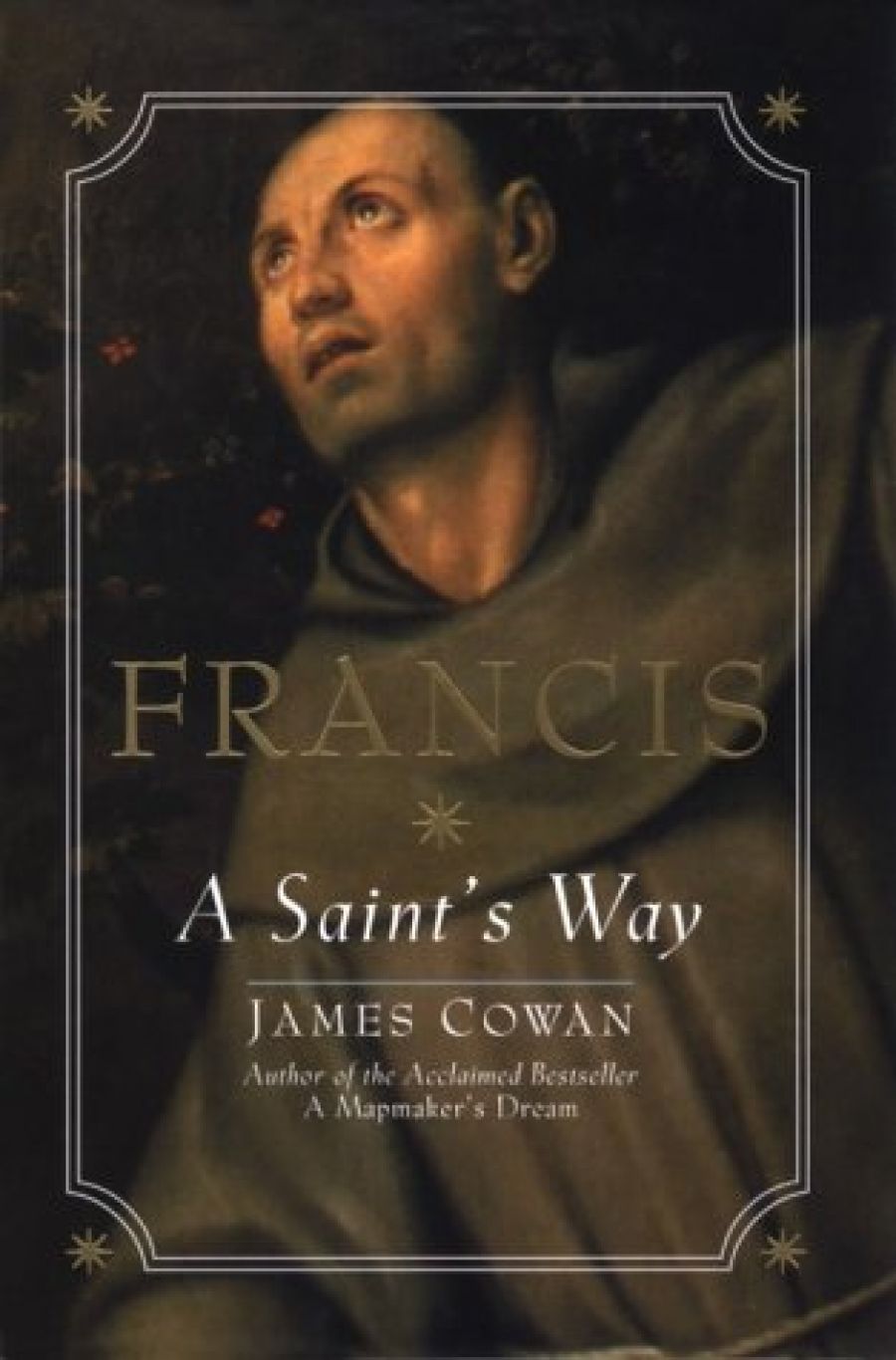
- Free Article: No
- Contents Category: Religion
- Review Article: Yes
- Article Title: Brother Fire, Sister Death
- Online Only: No
- Custom Highlight Text:
It wasn’t long before myths and legends grew up around the story of St Francis of Assisi. James Cowan is right to suggest that this process began before Francis died and that Francis himself allowed or willed it to happen. He may even have encouraged it: ‘Francis endeavoured to make a metaphor out of his own life.’
- Book 1 Title: Francis
- Book 1 Subtitle: A Saint’s Way
- Book 1 Biblio: Hodder, $29.95 hb, 180 pp
James Cowan probes these sorts of issues. Sometimes he gets carried away on clouds of puffy prose. He seldom shares the light-heartedness of his subject. By and large, though, he is prepared to dig beneath the difficult questions both Francis of Assisi and his myth raise for human self-understanding. He has chosen not to write a speculative biography of Francis. Far less is he a hagiographer, although he is deeply fascinated by his subject and even a little in love with Francis. He has spent a long time retracing Francis’s footsteps through central Italy and beyond, following leads to places that are still relatively isolated and inaccessible. The result is a more ruminative than informative book. In this it is part of a long tradition that stretches from the artwork of Giotto to Chesterton’s Saint Francis of Assisi and beyond.
Cowan chooses not to explore Francis as part of a complex Christian tradition. He tends to take that for granted, sharing with his Francis a tendency to ‘erase institutional religious authority simply by ignoring it’. The voice that spoke from a crucifix telling Francis to ‘rebuild my church’ has often been seen as asking Francis to re-create a Christian culture. Cowan interprets the command more individualistically: Francis had work to do on himself. Cowan is more keen to explore Francis’s relationship with Buddhism and Islam, especially Sufism. He likens Francis’s life of renunciation to that of Buddha. His renunciation is actually a form of acceptance, a point made by Chesterton who claimed that Francis ‘may well be said to have written a grammar of acceptance’. Cowan’s insights are often similar to Chesterton’s. But Cowan also situates Francis within the emerging merchant economy of the thirteenth century. The father Francis so famously rejected by stripping off his clothes in public, Pietro di Bernadone, was a cloth merchant and is presented as a representative as much of this new economy as of family ties.
Cowan is interested in looking at difficult themes, such as the role of pain and suffering in the life of Francis. Most accounts of Francis converge on this point: that he made light of his own pain, that he even welcomed it. Cowan is certainly part of a long tradition that sees Francis’s attitude not as masochistic but the opposite. Every loss for Francis was a gain because it freed him from attachment to anything less than God. On one occasion, annoyed that one of his followers had so much as touched a coin, he told the follower to take the coin outside and bury it in shit.
Cowan is most insightful when dealing with the role of language in Francis’s self-understanding. Intimately connected to that is Francis’s much-romanticised relationship with the natural world. For Cowan, Francis is more a poet than a theologian: ‘Unlike the hermits of the Egyptian desert who preferred silence in the face of the Absolute, Francis was a man in league with words.’ Part of his search for God was to bridge the gap between humans who could speak and the speechlessness of the rest of nature. Cowan follows this line of thought with persistence and subtlety. He reverts to it in explaining the many parables concerning Francis’s relationship with creatures. Francis is not Dr Dolittle. For all his chattiness, he is Dr Say Little: ‘nature is the language of the Invisible ... Nature literally spoke to him in the silent language of itself.’
This book, however, does have a nagging tendency to isolate Francis from humanity. Cowan is fascinated by asceticism and dispossession as means for an enlightened person to achieve transcendence. He is less able to see Francis, as a number of his contemporary followers have, as an advocate of social justice. Francis is said to have been born in a stable, another resonance with the story of Jesus. Over that stable, Francis is now described as ‘mirror of the world’. His spirituality did as much to let humans see possibilities for themselves in the here and now as it did to offer a window to an entirely alien world.


Comments powered by CComment